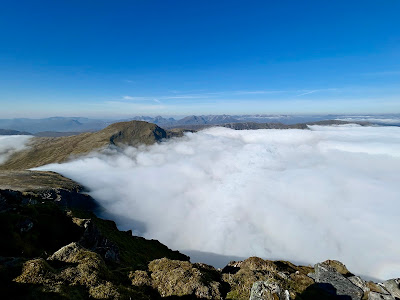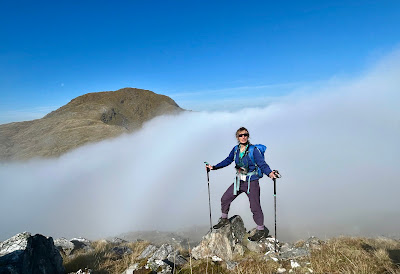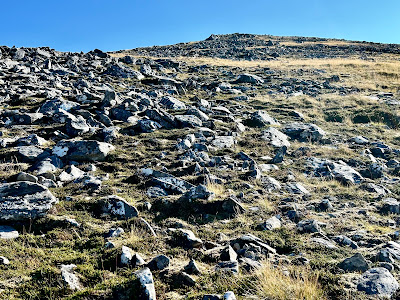 |
Sunday, 22 September 2024
Ascent: 1447 metresDistance: 41 kilometres cycling, 26 km walking, 15 km
Time: 8 hours 10 minutes
Lurg Mhor. 987m. 4hrs 12mins
Bidein a' Choire Sheasgaich. 945m. 5hrs 31mins
It was the prospect of revisiting these two hills, along with Maoile Lunndaidh and Sgorr Ruadh and the tantalising forecast of superb weather that had prompted me to offer to accompany Anna on her quest to complete the Munros. She hoped to climb these distant Munros before winter and preferred not to walk alone on these two extremely remote hills. We had a couple of email exchanges and agreed to meet at a cottage at Achmore after we had both driven up and climbed different hills on Wednesday. Anna arrived at 11pm after climbing 4 Munros in Knoydart. We had only met briefly before on a casual encounter on the Glomach Falls path. Her enthusiasm and determination to finish climbing the Munros were infectious. I had been similarly driven when finishing my Munro rounds. She said she would like some company in climbing some of the more remote Munros she had to climb. I offered to help; my passion for the mountains, which had languished since COVID, had been reignited.
After 3 hard but brilliant days in the mountains and a late-night finish on Friday, we checked that the Indian Summer would extend to Sunday and decided to take a rest day on Saturday. We had a lazy morning, eating, talking, looking at photos, sorting our stuff, drying our shoes and checking my bruises and the bikes. I was urged to remove the toe clips from my bike to reduce the probability of any more strapped-in somersaults. We drove to Plockton for an al fresco lunch, meandered around the village, pottered around Lochalsh, walked across the Skye Bridge and did some food shopping. We arrived back at the house by 6pm and prepared an early dinner compared to the three previous nights. I was told to be up by six for the big day. We managed to get off by 7:20, and we were cycling from Attadale well before 8am.
The weather was cooler, and there was a morning breeze, but we hadn't started any of our previous walks before 11am, chatting over breakfast and knowing that we were on the doorstep of the mountains. Another car was already parked at Attadale, and a walker wearing a stalker's hat was setting out on his bike. We left about ten minutes later, after unloading the bikes and donning appropriate clothing for the cooler conditions. The first couple of kilometres were flat, and apart from slowing to watch a large stag hiding in the bracken, we were rolling along fine.
We caught up with the man in the hat, let's call him George, who was perplexed about which track to take at a junction. I identified the right route by using OS maps online after remembering that I had taken the wrong track on this route when climbing Beinn Dronaig three years ago. Anna was unfolding and refolding her paper map that was 20 years old and did not show the more recent paths, but hey ho, some people are still fixated by analogue technologies. We found and crossed the metal bridge over the river and began a ferociously steep climb on the other side. George, his real name, had joined us; he was also heading for Lurg Mhor. We all pushed our bikes up the next section. I was pleased that George's hybrid bike was as old but probably not as heavy as mine; we had excuses when superwoman rode off on her lightweight steed.
George was a geordie with only half a dozen Munros to go, including Lurg Mhor. Anna made a breakaway once we reached the rideable section so she could stop ahead to take photos of the two of us as we chatted away in an animated conversation about our common interests. George had done the Bob Graham round in the Lake District, and we both had competed in marathons and similar races 30 years ago. We were called a pair of sweetie wives for blethering whilst riding. When she rode past us again to get another set of photos, she asked if her bum looked big on the bike. Yes, we both retorted, without even looking.
After some longer, flatter sections, the track ramps up again, and the gravel gets bigger and lumpier. We were all reduced to pushing bikes again to reach the high point of the ride at 340 metres. There are then 3 or 4 kilometres of mainly downhill cruising to the bridge over the Black Water. Our schussing was interrupted by some sensational views of Sheasgaich and Lurg Mhor peeping out of a duvet of white clouds. The glens were green and golden, lit up by shafts of sunshine that we were also blessed with. The temperature inversion had shrouded the nearby Corbett, Beinn Dronaig, in clouds, and to the east, a large bank of white clouds completed the canvas.
We stopped at the Black Water Bridge to admire the deep gorge, take more photos and, well, chat whilst not riding. The final two kilometres were easy cycling past Ben Dronaig Lodge, where we saw an eagle circling over Creag Dhubh Mhor. It was already a magical day with the best yet to come as we chained our bikes in a butterfly configuration and set out on the path leading to Loch Calavie. Beinn Sheasgaich and Lurg Mohr had been recaptured by clouds, but it was only 10am, and there was time for this to be burnt off with the chance of breaking through the clouds and discovering a temperature inversion.
Shortly after reaching the shore of Loch Calavie, there is a sign for the steep but good path up the grassy slopes to the bealach between the two Munros. We made steady progress as we entered the cloud layer, which continued until the bealach, a 380-metre climb. The path between Sheasgaich and Lurg Mhor crosses here and there is a final 260 metres of ascent to Lurg Mhor. We emerged from the cloud and gazed down at our brocken spectres. Anna was more excited by the temperature inversion and spent the first fifteen minutes at the summit taking photos of the vista of the peaks as the top of the cloud layer descended to reveal a wrap-around horizon of shapely mountains against the hooloovoo blue skyline. It was a photographer's heaven.
Back in the real world, George ate his lunch, and I tidied up the cairn. George was on a mission to get back to Newcastle, so it was time for farewells. He had been good company, and if he reads this, thanks and best wishes for your final Munro next year. He insisted on taking a photo of us against the parade of mountains emerging from the white cloud. We stayed for a while and had some lunch before beginning the descent to the bealach, which was still shrouded in the cloud. The ascent of Bidein a' Choire Sheasgaich was an easy 230 metres of climbing. There was no rush; we had spent 45 minutes on the summit of Lurg Mhor and spent another half hour on Sheasgaich as we identified the myriad of peaks. Anna had an app that did it for you. She's also fixated on digital technologies apart from online maps!? I tried to name them by memory, and it prompted some differences that weren't going to be resolved by Anna's map reading. The main advantage of the app is that you can download the results. (see photo below) There is no cloud for my memory; it is on my hard disc (brain), which is near capacity, and there are no upgrades available yet.
We descended by the southwest ridge to Sail Riabhach, facing into the afternoon sun. We occasionally stumbled on a faint path, but the direction was obvious along the walk highland route. It was 4 kilometres back to the bikes, where we slaked our thirst from a waterfall on the Black Water. We thought about bathing, but it was after 5pm and we had a 13-kilometre cycle ride back to Attadale. The cycle to the Black Water Bridge is easy going, but there are 3 or 4 kilometres of ascent, which involved some pushing before we reached the 340 metre high point of the track. The descent on the chunky gravel was far too steep for my calliper brakes to hold me, and I had no desire to repeat any accidental gymnastics.
The final few kilometres allowed us to let speed be our friend, and we were back at Attadale before 7pm. It had been another wonderful day. The last five days have given us perfect conditions and visibility, the longest continuous spell of radiant, sun-filled hillwalking days since 1993. John, Keith and I had 7 consecutive days of sunny conditions as we completed the whole of Knoydart, the Skye Ridge and the Aonach Eagach Ridge on the way home, giving us 25 of the more difficult Munros in the week.
This time, as well as the weather and stunning views, the more sedate pace, stops to enjoy the moment, and the company made it an equally memorable trip. After a year or more of treading water and reflecting on the past, the last few days inspired me to rediscover my free spirit, thinking about the future and the need to get out more.
We returned to the house elated by what we had achieved in the last few days. Anna now has only 8 Munros to go. She is a force of nature, and her iPhone is a digital wand that produces magical photos.
It began to rain as I left for home the next morning after we had packed and cleaned the house. My mood was one of huge contentment, laced with a melancholy that the jaunt was over. Over the last thirty-five years, with an average of 60 Munros and Corbetts a year, I know that hillwalking doesn't get much better than what we experienced over the past four or five days.
 |
| Gravel and Gravity |
 |
| The path up from Loch Calavie |
 |
| The climb from Loch Calavie, Beinn Dronaig behind |
 |
| Approaching the summit of Lurg Mhor |
 |
| Meall Mor, the Lurg Mhor top |
 |
| Sheasgaich from Lurg Mhor |
 |
| George having lunch on Lurg Mhor |
 |
| Cheesecake and the Analogue Princess |
 |
| Lurg Mhor from Sheasgaich |
 |
| Sheasgaich summit looking to Torridons |
 |
| Anna's app that identifies Mountains |
 |
| Bike shed |
 |
| Drink time |
 |
| The long and lonely pedal out past Bendronaig Lodge |
 |
| Speed Bonnie Bike |
 |
| Golden Day(s) |






































